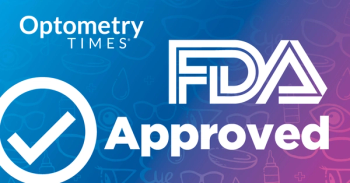
- November digital edition 2021
- Volume 13
- Issue 11
Optic disk swelling in an asymptomatic patient with diabetes
Diabetic papillitis is relatively rare, found in type 1 and 2 diabetes patients
A 63-year-old woman with type 2
Background
She reported taking lisinopril for hypertension, levothyroxine for hypothyroidism, and smoking a single pack of cigarettes daily for 20 years. In-office blood pressure measured 168/104. The patient also reported a lot of stress-eating, a 15 lb weight gain during the COVID-19 pandemic (current body mass index = 34.1 kg/m2), and had received her second dose of an mRNA vaccine 4 weeks before our visit.
Compared with her most recent spectacle prescription (3 years previously from another provider), I found a 2.5 diopter myopic shift in each eye. Ocular motilities, pupils, and external exams were unremarkable save early nuclear sclerotic cataract formation in each eye, with best-corrected visual acuities of 20/20 and intraocular pressures of 19 mm Hg. Dilated exam revealed normal optic nerves and maculae, with no evidence of diabetic retinopathy in the posterior pole or retinal periphery. Posterior pole images appear above in Figure 1.
Proposed treatment I had a long discussion with this patient about her suboptimal glucose and blood pressure control and recommended she see her primary care provider (PCP) to intensify treatment. We discussed the risk of diabetic retinopathy and other vascular complications due to chronic hyperglycemia, hypertension, and diabetes duration. I recommended she discontinue smoking and asked if she wanted to quit, to which she replied in the affirmative.
We also discussed refractive fluctuation due to hyperglycemia, and she elected to try to improve her blood glucose control and return to my office for repeat refraction once her HbA1c was less than 8%. I sent a detailed note to her PCP about my findings, recommendations, and concerns.
Follow-up
The patient returned to my office 4 months later and had been placed on weekly semaglutide injection (Ozempic, Novo Nordisk), long-acting insulin degludec (Tresiba, Novo Nordisk), transdermal nicotine patches, and atenolol, in addition to her previous medications.
She had lost 11 lb of weight, her most recent HbA1c was 6.8%, and her blood pressure now measured 145/95. Repeat refraction showed a 1.00 diopter hyperopic shift from her previous visit, but best-corrected vision of 20/20 OD and 20/30- OS. Pupils and extraocular muscles again appeared normal.
My first suspicion was worsening cataract in the left eye vs new-onset diabetic macular edema. Dilated exam again showed minimal
Findings
I discussed my findings with the patient. Based on her presentation, I told her I believed she had diabetic papillitis (DP) but wanted a retina consult to be sure. She was seen that day by a local retina specialist who concurred with my impression and referred her to a neuro-ophthalmologist the next week. In turn, that physician agreed with our clinical impressions, noting normal color vision and visual fields in each eye but also detected a subtle afferent pupillary defect on the left side. A sedimentation rate was ordered and was normal. He told the patient she likely had DP vs emerging nonarteritic anterior ischemic optic neuropathy (NAION). Neuroimaging was not ordered, per the neuro- ophthalmologist, as there was no evidence of bilateral disk edema.
Diabetic papillitis
DP is a relatively rare condition encountered in both type 1 and type 2 diabetes.1 Case reports show it can occur with or without comorbid diabetic retinopathy or macular edema in 1 or both eyes, and it has been associated with rapid improvement in blood glucose control and small optic disks.2,3 The proposed mechanism is vasodilation of optic nerve capillaries with reduced axoplasmic flow, resulting in disk swelling and splinter hemorrhages of the optic nerve.
Some experts dispute whether it is a distinct entity from NAION,4 but the visual prognosis is typically better than NAION (most patients maintain vision < 20/40) and altitudinal visual defects are absent. Fluorescein angiography is reported to reveal early disk leakage in DP, whereas disk hypoperfusion is a characteristic of NAION.
Interestingly, glucagon-like-peptide 1 receptor analogs (GLP-1 RA), such as exenatide, have been shown to induce capillary dilation via nitric oxide,5 and I am suspicious that use of semaglutide, a more potent GLP-1 RA, may have provoked DP in tandem with a rapid and dramatic drop in HbA1c and blood pressure.
Treatment
There is no definitive treatment for DP, though subtenon’s injections of steroids and anti-VEGF agents have been shown to improve disk and any associated macular edema.6-8 The patient will be followed by neuro-ophthalmology in 6 weeks, who reassured her that her visual prognosis is likely good. Only time will tell.
References
1. Regillo CD, Brown GC, Savino PJ, et al. Diabetic papillopathy. Patient characteristics and fundus findings. Arch Ophthalmol. 1995;113(7):889- 895. doi:10.1001/archopht.1995.01100070063026
2. Ostri C, Lund-Andersen H, Sander B, Hvidt-Nielsen D, Larsen M. Bilateral diabetic papillopathy and metabolic control. Ophthalmology. 2010;117(11):2214-2217. doi:10.1016/j.ophtha.2010.03.006
3. Sebai I, Chihaoui M, Elfeleh E, et al. Diabetic papillopathy after intensification of insulin therapy: A case report. Rev Med Interne. 2019;40(3):188-190. doi:10.1016/j.revmed.2018.08.007
4. Slagle WS, Musick AN, Eckermann DR. Diabetic papillopathy and its relation to optic nerve ischemia. Optom Vis Sci. 2009;86(4):e395-e403. doi:10.1097/OPX.0b013e318198927c
5. Chai W, Zhang X, Barrett EJ, Liu Z. Glucagon-like peptide 1 recruits muscle microvasculature and improves insulin’s metabolic action in the presence of insulin resistance. Diabetes. 2014;63(8):2788-2799. doi:10.2337/db13-1597
6. Giuliari GP, Sadaka A, Chang PY, Cortez RT. Diabetic papillopathy: current and new treatment options. Curr Diabetes Rev. 2011;7(3):171- 175. doi:10.2174/157339911795843122
7. Yildirim M, Kilic D, Dursun ME, Dursun B. Diabetic papillopathy treated with intravitreal ranibizumab. Int Med Case Rep J. 2017;10:99- 103. doi:10.2147/IMCRJ.S132479
8. Al-Haddad CE, Jurdi FA, Bashshur ZF. Intravitreal triamcinolone acetonide for the management of diabetic papillopathy. Am J Ophthalmol. 2004;137(6):1151-1153. doi:10.1016/j.ajo.2004.01.032
Articles in this issue
about 4 years ago
Avoid medical malpractice suitsabout 4 years ago
The many options of vision correctionabout 4 years ago
Taking a closer look at acquired blepharoptosisabout 4 years ago
Contact lens overwear leads to short-term, long-term consequencesabout 4 years ago
Optic Neuritis and COVID-19 vaccine connection?about 4 years ago
A guide to the latest presbyopia-correcting IOLsabout 4 years ago
Generic vs Branded: When RX makes a differenceNewsletter
Want more insights like this? Subscribe to Optometry Times and get clinical pearls and practice tips delivered straight to your inbox.













































.png)


